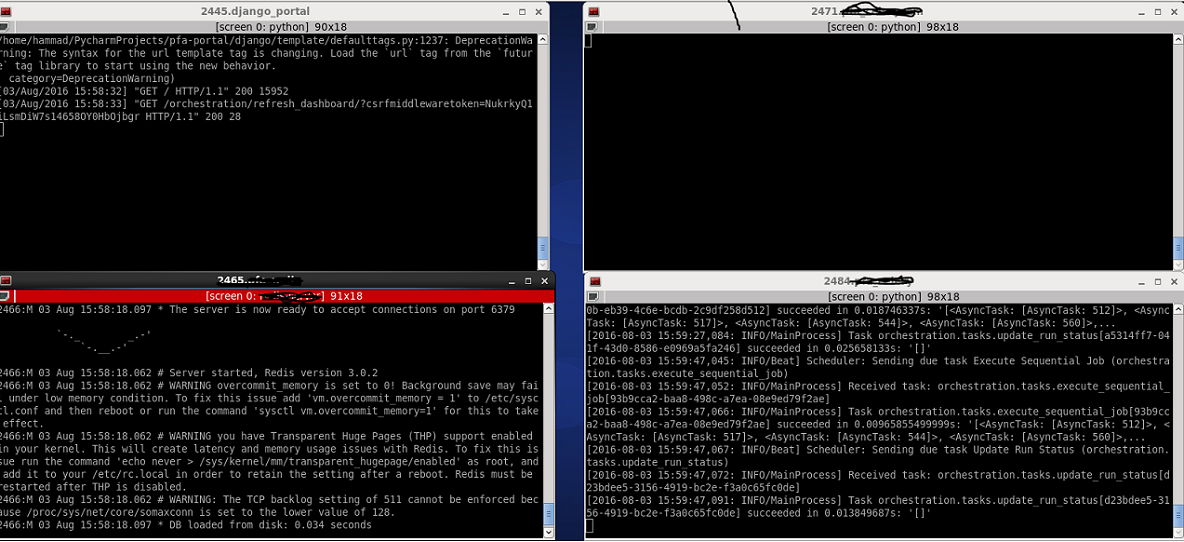Linux Based Monitoring Setup
Last Updated on October 3, 2022 by Hammad Rauf
This post describes how to setup easy to re-use monitoring on a Linux desktop system. We will need Screen and Terminator. We will monitor the Django (A python web application) console output.
Screen – A virtual Terminal Emulator
We will first install Screen. Screen is a Virtual Terminal Emulator specially created for multitasking. It allows you to start a program that logs output to console, in an off-screen session. You can later Attach or Detach to that screen session to look at the output.
Terminator – A Terminal program
Terminator is a fancy Terminal with easy to use launch options. It is available through the EPEL yum repository.
Install Required Tools
sudo yum install screen sudo yum install terminator
OR
sudo apt-get install screen sudo apt-get install terminator
Script for Starting Screen Sessions
Save the following scripts as “start-django-portal.sh” in /home/username folder. Then chmod +x FileName.sh.
#!/bin/sh screen -S django_portal -md python ~/PycharmProjects/mysite/manage.py runserver & sleep 4 screen –ls /usr/bin/firefox http://127.0.0.1:8000
Script for Monitoring Screen Sessions
Save the following scripts as “monitor-screens.sh” in /home/username folder. Then chmod +x FileName.sh.
#!/bin/bash
DISP_ARRAY=(636x420+0+0 636x420-0+0 636x420+0-0 636x420-0-0)
DISP_ARRAY2=(77x23+0+0 77x23-0+0 77x23+0-0 77x23-0-0)
COUNT=0
for scr in $(screen -ls | grep "Detached" | awk '{print $1}')
do
# echo $scr
echo ${DISP_ARRAY[$COUNT]}
# gnome-terminal -e "screen -r $scr" --geometry=${DISP_ARRAY2[$COUNT]} --background=black --foreground=white --title=$scr
terminator -e "screen -r $scr" --geometry=${DISP_ARRAY[$COUNT]} --title=$scr &
COUNT=$(((COUNT+1)%4))
done
exit $?Desktop Launcher for Screen Start
This launcher is for GNOME Desktop. Save the following as “start-django-portal.desktop” in /home/username/Desktop folder. You can save a suitable screen capture PNG image in /home/username/Icons folder to work as icon
#!/usr/bin/env xdg-open [Desktop Entry] Version=1.0 Type=Application Name=Start Django-Portal Icon=/home/username/Icons/img.PNG Exec="/home/username/start-django-portal.sh" Comment=Script to start Django-Portal Categories=Development; Terminal=false
Desktop Launcher for Screen Monitor
This launcher is for the GNOME desktop. Save the following as “monitor-screens.desktop” in /home/username/Desktop folder. You can save a suitable screen capture PNG image in /home/username/Icons folder to work as icon.
#!/usr/bin/env xdg-open [Desktop Entry] Version=1.0 Type=Application Name=Monitor Screens Icon=/home/username/Icons/img2.PNG Exec="/home/username/monitor-screens.sh" Comment=Script to monitor detached Screen sessions Categories=Development; Terminal=false

Further Reading
Have a look at the Screen manual pages (or try this link) for more insight into using screen.



